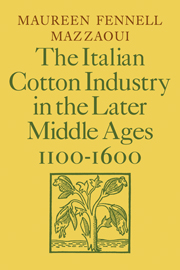Book contents
- Frontmatter
- Contents
- List of illustrations
- Preface
- List of abbreviations
- Map
- Introduction
- PART ONE THE ROLE OF COTTON IN THE MEDITERRANEAN ECONOMY
- PART TWO THE ORGANIZATION OF THE NORTH-ITALIAN INDUSTRY
- PART THREE THE GROWTH OF COTTON MANUFACTURE NORTH OF THE ALPS
- APPENDICES
- I Costs of production for cotton yarn and cloth in Milan in the early sixteenth century
- II The products of the Italian cotton industry
- Notes
- Select bibliography
- Index
II - The products of the Italian cotton industry
Published online by Cambridge University Press: 05 March 2012
- Frontmatter
- Contents
- List of illustrations
- Preface
- List of abbreviations
- Map
- Introduction
- PART ONE THE ROLE OF COTTON IN THE MEDITERRANEAN ECONOMY
- PART TWO THE ORGANIZATION OF THE NORTH-ITALIAN INDUSTRY
- PART THREE THE GROWTH OF COTTON MANUFACTURE NORTH OF THE ALPS
- APPENDICES
- I Costs of production for cotton yarn and cloth in Milan in the early sixteenth century
- II The products of the Italian cotton industry
- Notes
- Select bibliography
- Index
Summary
The majority of the technical prescriptions of the Italian guild statutes were concerned with mixed fabrics which accounted for the greatest proportion of the total output of the cotton industry. These included combinations of cotton with silk or woolen yarn. The finely woven ogellata (ogielata, ogilade) and the panisellus were silk/cotton mixtures. Sciamiti were heavy mixed fabrics of silk and cotton or silk and linen. They were sometimes made with a napped surface (sciamiti pillosi). Both the plain and napped varieties were utilized for canopies, bed curtains and coverlets. The pannus bambaceus combined cotton with either silk or wool. The pannus divisatus, which was made in Milan and also in France and England in the late Middle Ages, contained dyed yarns of wool or silk and cotton.
Far commoner were the mixtures containing varied proportions of cotton and linen or hemp threads. Of these the most popular were the bombasine (made with hemp), the terlici (with linen and hemp), the burdi, the valessi (valesii, valescii) and the acordolati (with linen). Each type was susceptible of numerous variations in dimensions, weight and finishing processes. They ranged from fine to coarse, in diverse lengths and widths with plain or napped surfaces. Mixed fabrics were made with stripes, checks or geometric designs produced by the use of dyed yarns or special weaves.
- Type
- Chapter
- Information
- The Italian Cotton Industry in the Later Middle Ages, 1100–1600 , pp. 166 - 167Publisher: Cambridge University PressPrint publication year: 1981



